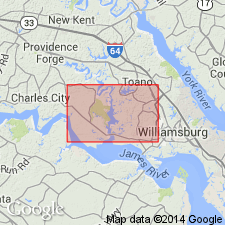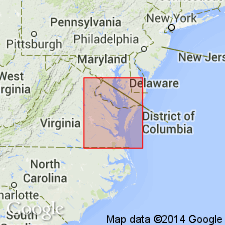
- Usage in publication:
-
- Chuckatuck Formation
- Modifications:
-
- Named
- Dominant lithology:
-
- Sand
- Silt
- AAPG geologic province:
-
- Atlantic Coast basin
Summary:
Chuckatuck Formation is here formally named in Isle of Wight Co., southeastern VA. Unit has been previously mapped in the area of the type section as Wicomico Formation (Wentworth, 1930) and Windsor Formation (Coch, 1968; Oaks and Coch, 1973). Chuckatuck is an upward-fining sequence with a basal channel deposit of poorly sorted, cobbly to pebbly sand; a middle moderately to well sorted, medium to fine sand with cross to planar bedding; and a capping clayey sand or organic-rich silt. Unit displays marked vertical and lateral lithologic variations. Basal sediments were deposited on a dissected coastal plain under fluvial and paludal conditions, while the upper Chuckatuck was deposited in tidally influenced bay and estuarine environments. Thickness at the type section in Smith pit is 28.8 ft. It is the principal surficial unit under the Grafton flat and elsewhere unconformably underlies the Shirley Formation (new name). Unit disconformably overlies the Charles City (new name) or the Windsor Formation. Exact age of the Chuckatuck is uncertain, but it is confined by the late middle Pleistocene age of the Shirley, and the probable early Pleistocene age of the Charles City.
Source: GNU records (USGS DDS-6; Reston GNULEX).

- Usage in publication:
-
- Chuckatuck Formation*
- Modifications:
-
- Overview
- Areal extent
- AAPG geologic province:
-
- Atlantic Coast basin
Summary:
Middle(?) Pleistocene Chuckatuck Formation is mapped in the southern Virginia Coastal Plain region primarily along the James, Nottoway, and Blackwater Rivers. Thickness ranges from 0 to 26 ft.
Source: GNU records (USGS DDS-6; Reston GNULEX).

- Usage in publication:
-
- Chuckatuck Formation
- Modifications:
-
- Overview
- AAPG geologic province:
-
- Atlantic Coast basin
Summary:
Nomenclature on State map follows Johnson and Berquist (1989). Chuckatuck Formation described as light- to medium-gray, yellowish-orange, and reddish-brown sand, silt, and clay and minor amounts of dark-brown and brownish-black peat. Comprises surficial deposits of mid-level coast-parallel plains (altitude 50 to 60 ft) and equivalent riverine terraces. Eastward, unit is truncated by the Suffolk scarp; westward, along major stream drainages, unit is separated from the younger topographically lower Shirley Formation by the Kingsmill scarp and equivalent estuarine scarps. Fluvial-estuarine facies includes from bottom to top: channel-fill deposits of poorly sorted, cross-bedded, pebbly and cobbly sand interbedded, locally, with peat and sandy silt rich in organic matte; moderately well-sorted, cross-bedded to planar bedded, fine- to medium-grained sand; clayey silt and sandy and silty clay. Bay facies of coastwise plain includes a basal gravelly sand filling shallow paleochannels, a thin but extensive pebbly sand containing heavy mineral laminae and OPHIOMORPHA burrows, and an upper, relatively thick, medium- to fine-grained silty sand and sandy silt. Thickness ranges 0 to 26 ft. Age is middle(?) Pleistocene.
Source: GNU records (USGS DDS-6; Reston GNULEX).
For more information, please contact Nancy Stamm, Geologic Names Committee Secretary.
Asterisk (*) indicates published by U.S. Geological Survey authors.
"No current usage" (†) implies that a name has been abandoned or has fallen into disuse. Former usage and, if known, replacement name given in parentheses ( ).
Slash (/) indicates name conflicts with nomenclatural guidelines (CSN, 1933; ACSN, 1961, 1970; NACSN, 1983, 2005, 2021). May be explained within brackets ([ ]).

